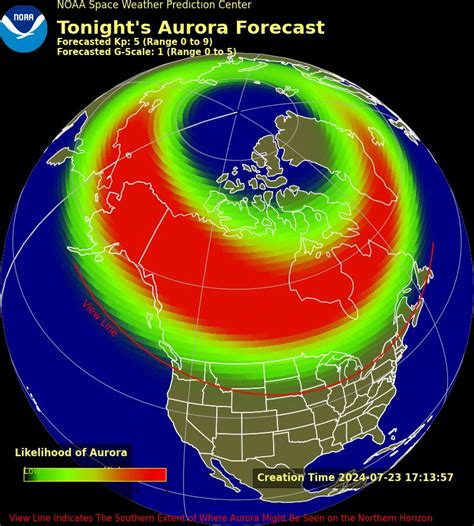
A surge of geomagnetic activity could make the aurora borealis, also known as the Northern Lights, visible across as many as 24 states this week. The Space Weather Prediction Center (SWPC), a division of the National Oceanic and Atmospheric Administration (NOAA), has issued an aurora watch, predicting the dazzling light display may extend much further south than usual.
The increased visibility is due to a coronal mass ejection (CME) that erupted from the sun and is expected to reach Earth, potentially triggering a strong geomagnetic storm. According to the SWPC, the aurora could be visible in states as far south as Pennsylvania, Iowa, and Oregon, offering a rare opportunity for many Americans to witness this natural phenomenon. While the prediction remains subject to change, skywatchers across the nation are encouraged to monitor local forecasts and prepare for a potential celestial spectacle.
Geomagnetic Storm Brews, Expanding Aurora Visibility
The impending arrival of a CME is set to potentially ignite a geomagnetic storm, significantly amplifying the reach of the Northern Lights across the United States. Typically confined to the higher latitudes near the Arctic Circle, the aurora borealis may grace the skies of regions much further south, creating a breathtaking display for millions. The SWPC carefully monitors solar activity and its potential impact on Earth, providing crucial warnings and forecasts to various sectors, including satellite operators, power grid managers, and aviation companies.
“When the charged particles from a CME interact with the Earth’s magnetic field, they can cause geomagnetic storms,” explained Dr. Elizabeth MacDonald, a space scientist at NASA’s Goddard Space Flight Center, though she was not directly involved in this forecast. “These storms can disrupt satellites, radio communications, and even power grids, but they also create the beautiful aurora.”
The strength of a geomagnetic storm is measured using the Kp index, a scale ranging from 0 to 9, with higher numbers indicating stronger storms. The current forecast suggests a potential Kp index of 7, which is classified as a G3 or “strong” geomagnetic storm. At this level, the aurora can be visible at latitudes as low as 50 degrees, bringing it within reach of a significant portion of the U.S. population.
Prime Viewing Conditions and Preparation
For those hoping to catch a glimpse of the aurora, several factors play a critical role in maximizing visibility. Dark skies are paramount, so escaping city lights and finding a location with minimal light pollution is essential. Rural areas, away from streetlights and other artificial illumination, offer the best viewing opportunities.
Weather conditions also play a crucial role. Clear skies are a must, as clouds will obscure the aurora. Checking local weather forecasts for cloud cover is highly recommended before venturing out.
Patience is also key. Auroral displays can be unpredictable, with intensity and activity levels fluctuating throughout the night. Spending several hours observing the sky increases the chances of witnessing a spectacular show.
While the aurora is visible to the naked eye, using a camera can enhance the experience. Cameras with high ISO capabilities and wide aperture lenses can capture details that may be difficult to see with the unaided eye. A tripod is essential for capturing sharp, long-exposure images of the aurora. Several online resources and apps provide real-time aurora forecasts and alerts, helping skywatchers plan their viewing sessions. These resources often include maps showing the predicted aurora oval and the likelihood of visibility in different areas.
The Science Behind the Spectacle: Understanding CMEs and Geomagnetic Storms
The sun, a dynamic and ever-changing star, constantly emits a stream of charged particles known as the solar wind. Occasionally, the sun releases massive bursts of energy and plasma called coronal mass ejections (CMEs). These ejections travel through space at millions of miles per hour and, if directed towards Earth, can interact with our planet’s magnetic field, causing geomagnetic storms.
When a CME reaches Earth, the charged particles interact with the magnetosphere, the region of space surrounding Earth that is controlled by the planet’s magnetic field. This interaction compresses the magnetosphere and injects energy into the ionosphere, the upper layer of the atmosphere.
The energized particles then follow the Earth’s magnetic field lines towards the poles, where they collide with atoms and molecules in the atmosphere. These collisions excite the atmospheric gases, causing them to emit light. The color of the aurora depends on the type of gas being excited and the altitude at which the collisions occur. Oxygen atoms emit green and red light, while nitrogen atoms produce blue and purple hues.
The intensity and duration of a geomagnetic storm depend on several factors, including the size and speed of the CME, the strength and direction of its magnetic field, and the orientation of Earth’s magnetic field. Strong geomagnetic storms can disrupt radio communications, GPS signals, and power grids. They can also damage satellites and increase radiation exposure for astronauts and airline passengers.
Impacts of Geomagnetic Storms: Beyond the Aurora
While the aurora is the most visible and celebrated consequence of geomagnetic storms, these events can have significant impacts on various technological systems and infrastructure.
- Satellite Operations: Geomagnetic storms can disrupt satellite communications, navigation systems, and data transmission. The increased radiation and particle flux can damage sensitive electronic components, leading to malfunctions or even complete failure. Satellite operators often take precautionary measures during geomagnetic storms, such as temporarily shutting down non-essential systems and reorienting satellites to minimize exposure to radiation.
- Power Grids: Strong geomagnetic storms can induce electric currents in long transmission lines, potentially overloading transformers and causing power outages. Power grid operators closely monitor space weather forecasts and take steps to mitigate the risks, such as adjusting voltage levels and switching to alternative power sources. The 1989 geomagnetic storm that caused a major blackout in Quebec, Canada, serves as a stark reminder of the potential impact of these events.
- Radio Communications: Geomagnetic storms can disrupt radio communications, particularly high-frequency (HF) radio used by aviation, maritime, and amateur radio operators. The increased ionization in the ionosphere can absorb or distort radio signals, making it difficult to communicate over long distances.
- Navigation Systems: Geomagnetic storms can affect the accuracy of GPS and other satellite-based navigation systems. The disturbances in the ionosphere can delay or distort the radio signals used by these systems, leading to errors in positioning and timing.
- Aviation: Geomagnetic storms can increase radiation exposure for airline passengers and crew, particularly on flights over the polar regions. Airlines may adjust flight paths to avoid areas with higher radiation levels during strong geomagnetic storms.
States Potentially in the Aurora’s Path
Based on the NOAA’s Space Weather Prediction Center’s forecasts, the following states have the potential to witness the aurora borealis, depending on the storm’s intensity:
- Alaska
- Washington
- Idaho
- Montana
- North Dakota
- South Dakota
- Minnesota
- Wisconsin
- Michigan
- New York
- Maine
- Vermont
- New Hampshire
- Massachusetts
- Rhode Island
- Connecticut
- Pennsylvania
- Ohio
- Iowa
- Oregon
- Illinois
- Indiana
- Maryland
- Wyoming
It’s important to note that this is a prediction, and the actual visibility of the aurora may vary depending on the strength of the geomagnetic storm and local weather conditions. The further north a state is, the greater the likelihood of seeing the aurora.
Historical Significance and Cultural Interpretations
The aurora borealis has captivated humanity for centuries, inspiring myths, legends, and scientific inquiry across diverse cultures. In many indigenous cultures of the Arctic region, the aurora is seen as a spiritual phenomenon, often associated with ancestors, spirits, and the afterlife.
The Inuit people of Alaska and Canada believed the aurora to be the spirits of the dead playing ball in the sky. In Norse mythology, the aurora was seen as the reflection of the shields and armor of the Valkyries, female warriors who escorted fallen heroes to Valhalla.
The scientific understanding of the aurora has evolved significantly over time. Early theories attributed the aurora to sunlight reflecting off ice crystals in the atmosphere. It was not until the 18th century that scientists began to connect the aurora with magnetism and solar activity.
In modern times, the aurora continues to be a source of fascination and wonder, attracting tourists and researchers from around the world. The study of the aurora provides valuable insights into the workings of the sun, the Earth’s magnetosphere, and the interaction between the two.
Expert Insights and Continued Monitoring
The Space Weather Prediction Center (SWPC) plays a crucial role in monitoring solar activity and forecasting geomagnetic storms. The center uses a network of ground-based and space-based instruments to track solar flares, coronal mass ejections, and other space weather phenomena.
“We continuously monitor the sun and the space environment to provide timely and accurate forecasts of space weather events,” said Brent Gordon, a space weather forecaster at the SWPC. “Our goal is to provide warnings and alerts that can help protect critical infrastructure and ensure public safety.”
The SWPC works closely with various government agencies, private companies, and research institutions to develop and improve space weather forecasting models. The center also conducts outreach and education programs to raise awareness about the impacts of space weather and the importance of preparedness.
The current aurora watch is a reminder of the dynamic and interconnected nature of our solar system. While the aurora is a beautiful and awe-inspiring phenomenon, it is also a manifestation of powerful forces that can have significant impacts on our technology and infrastructure. By understanding these forces and preparing for their effects, we can mitigate the risks and continue to explore and enjoy the wonders of space.
FAQ: Northern Lights and Geomagnetic Storms
-
What causes the Northern Lights (aurora borealis)?
- The Northern Lights are caused by charged particles from the sun interacting with the Earth’s magnetic field and atmosphere. These particles collide with atoms and molecules in the atmosphere, exciting them and causing them to emit light. The colors of the aurora depend on the type of gas being excited and the altitude at which the collisions occur. Oxygen atoms emit green and red light, while nitrogen atoms produce blue and purple hues.
-
What is a coronal mass ejection (CME)?
- A coronal mass ejection (CME) is a massive burst of energy and plasma from the sun’s corona (outer atmosphere). These ejections travel through space at millions of miles per hour and, if directed towards Earth, can interact with our planet’s magnetic field, causing geomagnetic storms.
-
What is a geomagnetic storm?
- A geomagnetic storm is a disturbance of the Earth’s magnetosphere caused by solar activity, such as coronal mass ejections (CMEs) and high-speed solar wind streams. These storms can disrupt radio communications, GPS signals, and power grids. They can also damage satellites and increase radiation exposure for astronauts and airline passengers.
-
How can I see the Northern Lights?
- To see the Northern Lights, you need dark skies, clear weather, and a strong geomagnetic storm. Escape city lights and find a location with minimal light pollution. Check local weather forecasts for cloud cover. Use online resources and apps to monitor aurora forecasts and alerts. Patience is key, as auroral displays can be unpredictable.
-
What is the Kp index?
- The Kp index is a scale used to measure the strength of geomagnetic activity. It ranges from 0 to 9, with higher numbers indicating stronger geomagnetic storms. A Kp index of 7 or higher is considered a strong geomagnetic storm and can cause the aurora to be visible at lower latitudes.
Detailed Checklist for Aurora Viewing
To maximize your chances of witnessing a spectacular aurora display, it’s essential to be well-prepared. Here’s a detailed checklist to guide your planning:
-
Monitor Space Weather Forecasts:
- Regularly check the NOAA’s Space Weather Prediction Center (SWPC) website for the latest aurora forecasts and geomagnetic storm warnings.
- Download aurora forecast apps on your smartphone to receive real-time alerts and updates.
- Follow space weather experts and organizations on social media for timely information and insights.
-
Choose the Right Location:
- Select a location away from city lights and other sources of light pollution.
- Look for rural areas, parks, or open spaces with unobstructed views of the northern horizon.
- Consider elevation, as higher locations often offer better visibility.
-
Check the Weather Forecast:
- Ensure clear skies are predicted for the night of your viewing session.
- Monitor cloud cover maps and satellite imagery to identify areas with minimal cloud cover.
- Be prepared to adjust your viewing location if necessary due to changing weather conditions.
-
Gather Essential Equipment:
- Warm clothing: Dress in layers to protect yourself from the cold, especially during winter months. Include hats, gloves, scarves, and thermal underwear.
- Comfortable footwear: Wear insulated boots with good traction to navigate snowy or icy terrain.
- Flashlight or headlamp: Use a red-light flashlight or headlamp to preserve your night vision.
- Camera and tripod: Capture stunning images of the aurora with a camera that has high ISO capabilities and a wide aperture lens. Use a sturdy tripod to prevent camera shake during long exposures.
- Binoculars: Enhance your viewing experience with binoculars, which can reveal finer details of the aurora.
- Blanket or chair: Bring a blanket or chair to sit comfortably while observing the sky.
- Snacks and drinks: Pack snacks and drinks to keep yourself energized during your viewing session.
- Compass or GPS: Use a compass or GPS to navigate to your viewing location and orient yourself in the dark.
- Aurora viewing app: Several apps provide real-time aurora forecasts, maps, and viewing tips.
-
Prepare Your Camera:
- Use a wide-angle lens (e.g., 14mm to 24mm) to capture a broad view of the sky.
- Set your camera to manual mode to have full control over exposure settings.
- Use a high ISO (e.g., 800 to 6400) to capture more light.
- Set your aperture to the widest setting (e.g., f/2.8 or f/1.8) to let in as much light as possible.
- Use a long exposure time (e.g., 5 to 30 seconds) to capture the faint light of the aurora.
- Focus manually on a distant star or object.
- Use a remote shutter release or the camera’s self-timer to minimize camera shake.
-
Arrive Early and Be Patient:
- Arrive at your viewing location well before the predicted peak time of the aurora.
- Allow your eyes to adjust to the darkness for at least 20 minutes.
- Be patient and persistent, as auroral displays can be unpredictable and intermittent.
- Keep an eye on the northern horizon and scan the sky for faint green or red glows.
-
Respect the Environment:
- Stay on established trails and avoid disturbing vegetation or wildlife.
- Pack out all trash and leave your viewing location as you found it.
- Be mindful of noise and avoid making loud sounds that could disturb others.
- Respect private property and obtain permission before entering private land.
-
Stay Safe:
- Inform someone of your viewing plans and expected return time.
- Dress warmly and be prepared for cold weather conditions.
- Be aware of your surroundings and watch out for hazards such as ice, snow, and wildlife.
- Carry a cell phone and a portable charger in case of emergencies.
- If traveling alone, consider joining a guided aurora viewing tour.
By following this detailed checklist, you can increase your chances of witnessing a memorable aurora display and enjoy the beauty of the Northern Lights in a safe and responsible manner.
Expanding on the Scientific Significance of Aurora Research
The study of auroras extends far beyond mere aesthetic appreciation. It is a crucial component of understanding the complex interactions between the sun and Earth, offering invaluable insights into plasma physics, space weather, and the fundamental processes that govern our planet’s environment.
- Plasma Physics Laboratory in Space: The Earth’s magnetosphere and ionosphere, where auroras are generated, serve as a natural laboratory for studying plasma physics, the behavior of ionized gases. Scientists can observe how different types of plasma waves propagate and interact in this environment, providing data that is difficult or impossible to obtain in ground-based laboratories.
- Understanding Space Weather Effects: Studying auroras helps scientists understand how space weather events, such as geomagnetic storms, impact our technological infrastructure. By analyzing the intensity, location, and dynamics of auroras, researchers can gain insights into the processes that can disrupt satellite communications, power grids, and other critical systems.
- Tracing Energy Flow from the Sun to Earth: Auroras are a visible manifestation of the energy and momentum that flow from the sun to Earth. By studying auroras, scientists can trace the path of this energy and determine how it is transferred from the solar wind to the magnetosphere, ionosphere, and ultimately, the Earth’s atmosphere.
- Monitoring the Magnetosphere’s Response to Solar Activity: The aurora’s shape, intensity, and movement are directly influenced by the state of the Earth’s magnetosphere. By monitoring auroral activity, scientists can track changes in the magnetosphere caused by solar activity and assess the potential impact on Earth’s environment.
- Developing and Validating Space Weather Models: Auroral observations are used to develop and validate space weather forecasting models. By comparing model predictions with actual auroral activity, scientists can refine their models and improve their ability to forecast geomagnetic storms and other space weather events.
- Understanding Atmospheric Composition and Dynamics: The colors of the aurora provide information about the composition and dynamics of the Earth’s upper atmosphere. By analyzing the wavelengths of light emitted by the aurora, scientists can determine the types of gases present and their temperature and density.
- Studying the Coupling Between the Magnetosphere and Ionosphere: Auroras are a key indicator of the coupling between the magnetosphere and ionosphere, the two regions of space that are most directly affected by solar activity. By studying auroral activity, scientists can gain insights into the complex interactions between these two regions and how they influence each other.
- Improving Satellite Drag Models: Geomagnetic storms, often associated with auroras, cause the Earth’s atmosphere to expand, increasing the drag on satellites orbiting in low Earth orbit. Precise measurements of auroral activity contribute to improved models of atmospheric density and satellite drag, allowing for more accurate predictions of satellite trajectories.
- Exploring the Origins of the Earth’s Magnetic Field: While not directly related to the immediate generation of auroras, the study of the magnetosphere, which is intimately linked to auroral phenomena, is also connected to understanding the generation and maintenance of Earth’s magnetic field. This magnetic field is what shields us from the continuous bombardment of solar wind and harmful radiation.
In summary, aurora research is a multidisciplinary field that combines plasma physics, space weather forecasting, atmospheric science, and planetary science. By studying auroras, scientists can gain a better understanding of the complex interactions between the sun and Earth and develop tools to protect our technological infrastructure and ensure the safety of astronauts and airline passengers.









